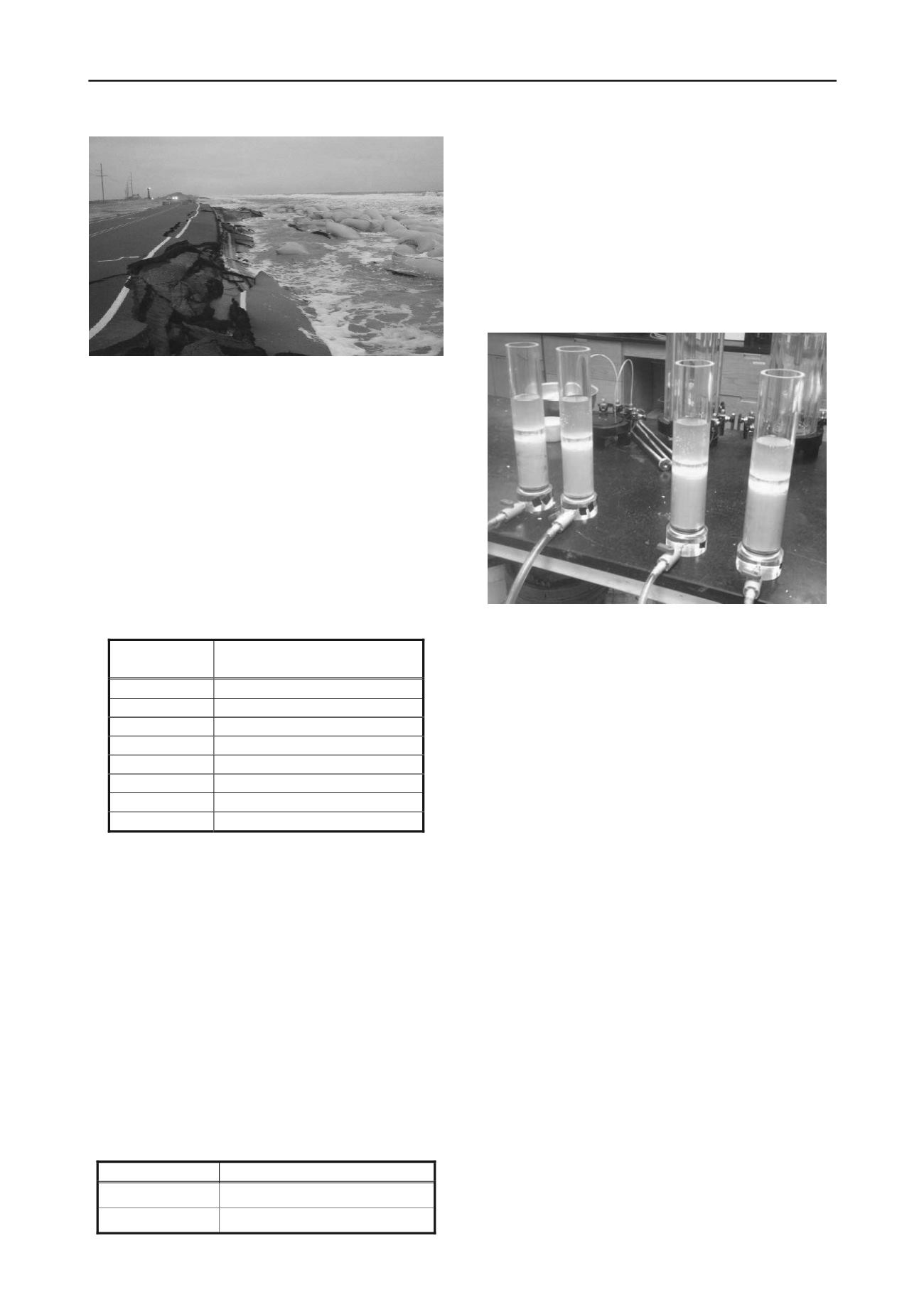
2566
Proceedings of the 18
th
International Conference on Soil Mechanics and Geotechnical Engineering, Paris 2013
figure 2. high ocean waves from hurricane sandy lap against
highway 12 and erode the underlying sand. (photo: news & observer,
nov. 14, 2012)
2. materials and methods
2.1. Sand and Specimen Preparation
four soil column specimens were prepared by dry pluviation
to a target relative density of 40%. the soil column specimens
had a 50.8 mm (2 in) diameter and an aspect ratio of 2:1.
ottawa 50-70 sand was used for the initial cementation trials,
because of the published results with the sand (deJong et al.,
2006, mortensen and deJong, 2011, montoya et al., 2013,
martinez et al., 2013). a summary of the sand characteristics
is listed in table i.
table i. ottawa 50-70 sand characteristics
ottawa 50-70
sand characteristics
d
50
(mm)
0.22
c
u
1.4
c
c
0.9
G
max
2.65
e
min
0.55
e
max
0.87
mineralogy
Quartz
shape
round
2.2. Biological Treatment Process
Sporosarcina pasteurii
(atcc 11859), a urea hydrolyzing
bacterium, was grown at 30 °c in an ammonium-Yeast
extract medium (atcc 1376: 0.13 mol l
-1
tris buffer
(ph=9.0), 10 g l
-1
(nh
4
)
2
so
4
, and 20 g l
-1
yeast extract).
individual ingredients were autoclaved separately and mixed
together post-sterilization. the growth medium was
inoculated with the
S. pasteurii
stock culture and incubated
aerobically at 30 °c in a shaking water bath (200 rpm) for
approximately 40 hrs before harvesting at a final optical
density (od
600
) of 0.8-1.0. cultures were centrifuged at 4000
g
for 10 min in 15 ml volumes and washed in fresh growth
medium. harvested bacteria were stored in the centrifuge vials
at 4 °c for a maximum of 2 days.
Urea-calcium cementation media was used to induce
ureolytic-driven calcite precipitation. a summary of the
components and concentrations are presented in table ii.
table ii. chemical recipe for cementation media
chemical
chemical concentration (m)
Urea
1.0
cacl
2
0.25
cementation treatments were performed by flooding the
top surface of the soil column, and allowing the cementation
media to freely drain through the sand (figure 3). Bacteria
were introduced into the soil during the initial cementation
flush. calcium chloride was not included in the initial
treatment with the bacteria to prevent precipitation during
inoculation. cementation treatments were repeated every 3 to
6 hours. two pore volumes of nutrients were used in each
treatment flush (concentrations of nutrients presented in table
ii). the cementation treatments were repeated for a total of 40
times.
figure 3. initial biological flush through soil columns. cementation
flushes allowed to free
drain through pluviated soil.
2.3. Specimen Shearing
after cementation was completed, the specimen was flushed
with water to remove residual chemicals from the cementation
treatments. the cemented sand was removed from the soil
columns. the cemented soil columns were then subjected to
unconfined compression tests until failure. a GeoJac
automated load actuator was used to perform the unconfined
compression test.
2.4 Mass of Calcium Carbonate Measurements
the mass of calcium carbonate was determined post-test using
methods outlined in astm d4373,
Standard Test Method for
Rapid Determination of Carbonate Content in Soils.
at the
end of the cementation treatments, oven dried cemented sands
are dissolved in hydrochloric acid and the resulting pressure
generated from the dissolution of calcium carbonate is
measured. the generated pressure is equated to an equivalent
mass of calcium carbonate. the percentage of mass of calcium
carbonate is expressed as the mass of calcium carbonate
divided by the mass of soil (not including calcium carbonate).
3. resUlts
3.1 Calcium Carbonate Content in Soil Columns
mass of calcium carbonate was taken in the top and bottom of
the cemented soil column, which are reported in table iii. as
indicated in table iii, the mass of calcite in the four soil
columns is relatively small compared to published results from
other micp treatment studies (Weil et al., 2011). however,
the cementation within the soil column was extremely uniform,
as indicated by the mass of calcium carbonate of the top and
bottom samples (table iii).


